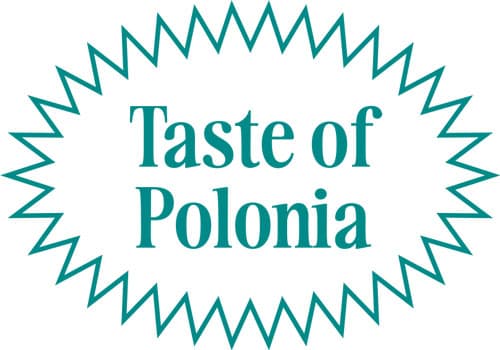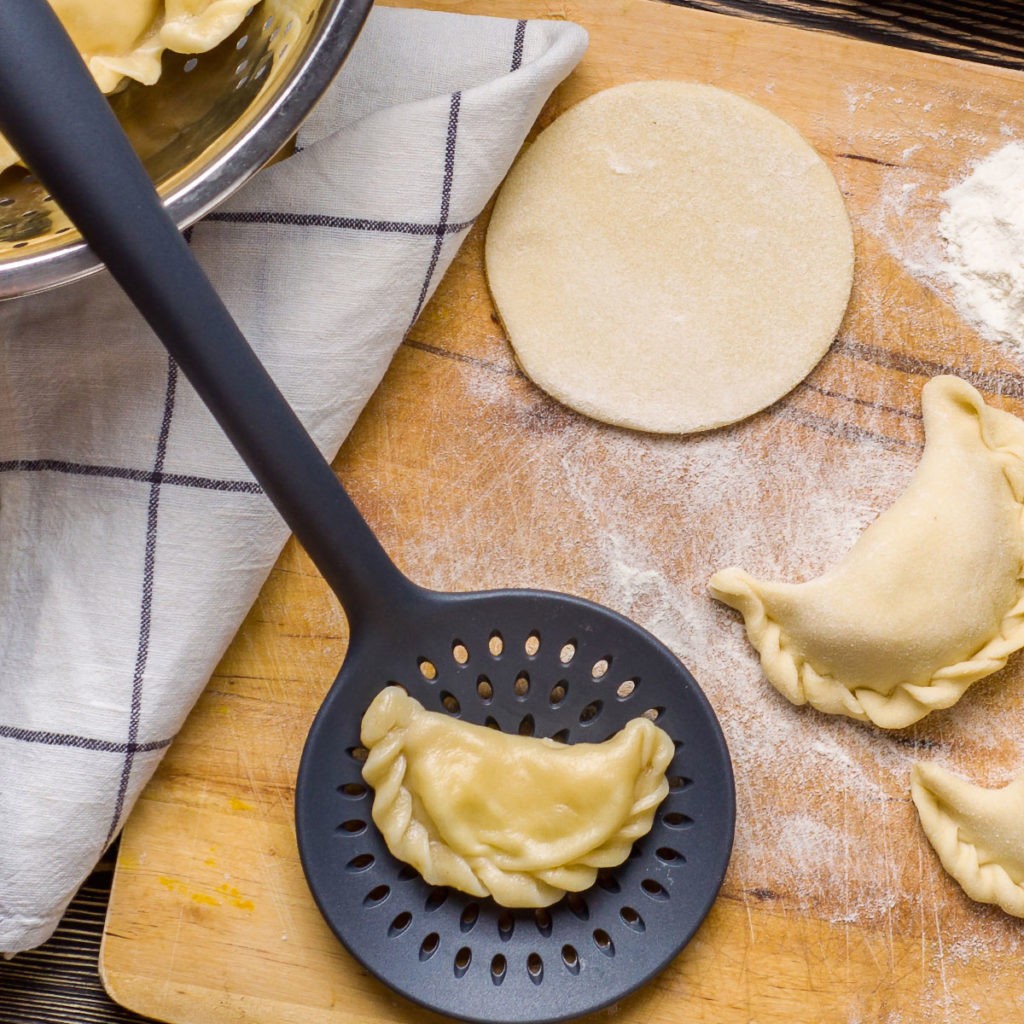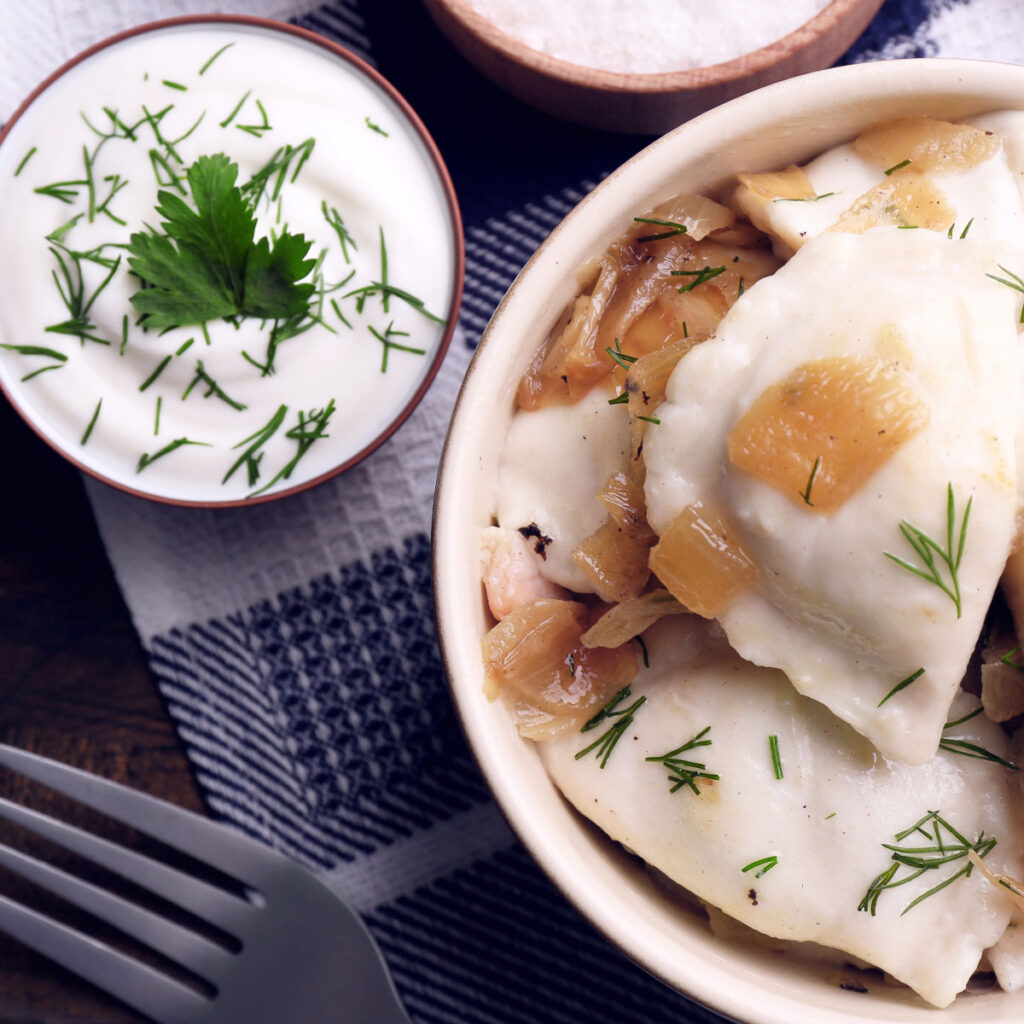30+ Best Pierogi Filling Ideas (+ Easy Recipes)
In this collection, we’ll delve into six main categories of pierogi fillings:
Absolute classics, savoury delights, fruit-filled temptations, seasonal treats, hidden regional gems, and inspired twists from the Polish diaspora.
Keep in mind; this list is but a glimpse into the diverse universe of pierogi fillings. Countless local variations and bold experiments await your discovery.
Unable to visit Poland right now? With a bit of pierogi dough and your creative spirit, you can embark on your own pierogi-making adventure at home.

Traditional Pierogi Fillings
Polish cuisine, much like the fillings in pierogi, follows the rhythm of the seasons.
Some fillings are perennial favourites, while others make their appearance solely during special occasions and festivities.
Here’s the guide to the most beloved pierogi fillings enjoyed throughout the country:
‘Ruskie’: Potatoes & Twaróg
Pierogi ruskie / ukraińskie
Polish for: Ruthenian / Ukrainian Pierogi
‘Ruskie’ are filled with mashed twaróg cheese and boiled potatoes, often mixed with finely chopped onions sautéed in butter and generously seasoned with black or herbal pepper (a type of herbal spice mix).
They are typically served with melted butter, pork cracklings, fried onions, or a dollop of sour cream. Historically, in Lviv, it was common to sprinkle ‘ruskie’ with caraway seeds.
‘Ruskie’ are one of the most popular fillings, commonly enjoyed in Polish households, as well as in affordable eateries such as milk bars, bistros, and staff/school canteens.
Their origins can be traced back to the historical territory of Red Ruthenia (Eastern Galicia), and their popularity has gradually expanded across the entire region.
Following the 2022 Russian invasion of Ukraine, numerous Polish establishments refrained from using the term ‘ruskie’ due to its unfortunate, but common misassociation with Russia (where this dish isn’t even recognized).
Consequently, as a symbol of solidarity with our eastern neighbour, they started using the term ‘Ukrainian pierogi’ or simply ‘potato and cheese pierogi’.
Interestingly, in Ukraine, this filling is at times dubbed as ‘Polish,’ perhaps hinting at its historical popularity among Polish communities residing in these regions.
Recipe:
Sauerkraut
Pierogi z kapustą (kiszoną)
Polish for: Sauerkraut Pierogi
‘Pierogi z kapustą’ feature a sharp-tasting filling of lacto-fermented sauerkraut, often combined with mushrooms, either wild or the more affordable but less aromatic button mushrooms.
Some recipes also incorporate cooked vegetables, such as carrots or parsley root.
To elevate sauerkraut’s flavour, it’s first simmered with bay leaves and allspice berries, until it reaches a tender consistency. Following that, it’s finely minced or chopped and then gently sautéed with onions.
For Polish Christmas Eve, which traditionally abstains from meat, sautéing is typically done using vegetable oil or butter, while on other occasions, lard is sometimes used as an alternative.
Sauerkraut is a beloved filling, especially in the latter part of the year, providing warmth and a hearty dose of vitamin C on those cold winter days.
While ‘pierogi z kapustą’ often grace festive tables, they’re versatile for everyday enjoyment, either as a standalone dish or complementing a cup of clear Barszcz Czerwony soup.
Recipes:
- Sauerkraut Pierogi
- Sauerkraut & Wild Mushrooms (upcoming)
- Sauerkraut & Button Mushrooms (upcoming)
Meat (Ground pork, beef, veal, poultry)
Pierogi z mięsem
Polish for: Meat Pierogi
‘Pierogi z mięsem’ are filled with cooked ground meat, often combined with finely chopped sautéed onions, and seasoned with salt, pepper, and a variety of herbs and spices.
Common meat options include ground pork, beef, veal, poultry like chicken or turkey, or a blend of these.
They are commonly accompanied by melted butter, crispy pork cracklings, fried onions, or a dollop of sour cream.
Unlike dumplings from other culinary traditions, pierogi always contain pre-cooked meat, never raw. Historically, this was a resourceful way to utilize meat leftovers, such as roasts and other dishes.
Even during times of scarcity, the flavourless remnants from broth-making found renewed purpose as pierogi filling. When seasoned skilfully, some might argue it embodied today’s ‘zero waste’ ethos perfectly.
Today, to preserve all the flavours, we can use purposefully cooked ground meat, often opting for an 80/20 meat-to-fat ratio to prevent the filling from drying out.
Seasonings vary widely between recipes and regions. There are no universal recommendations, feel free to season the filling to your liking.
Recipes:
- Meat Pierogi
- Chicken Pierogi (upcoming)
Sweet Cheese (Twaróg)
Pierogi z serem
Polish for: Cheese Pierogi
‘Pierogi z serem’ feature a filling of mashed twaróg cheese, sweetened with sugar and infused with vanilla. To adjust for varying twaróg moisture levels, some recipes incorporate sour cream to soften the filling.
Among Polish diaspora communities worldwide, where twaróg can be hard to find, substitutes like unsalted farmer’s cheese, ricotta, and even cream cheese are used.
These pierogi are typically served with fruit, a dollop of fruit jam, sweetened sour cream, whipped cream, or simply dusted with powdered sugar or drizzled with sweet sauces like chocolate or vanilla.
‘Pierogi z serem’ have a special place in Polish culinary history as one of the earliest recorded fillings. These historic recipes even include creative variations, where twaróg gets coloured with fruit juices and syrups.
Today, sweetened twaróg remains the most popular sweet filling, enjoyed in Polish households and budget-friendly eateries. It’s also one of the top choices among ready-made pierogi products available in stores.
Recipe:
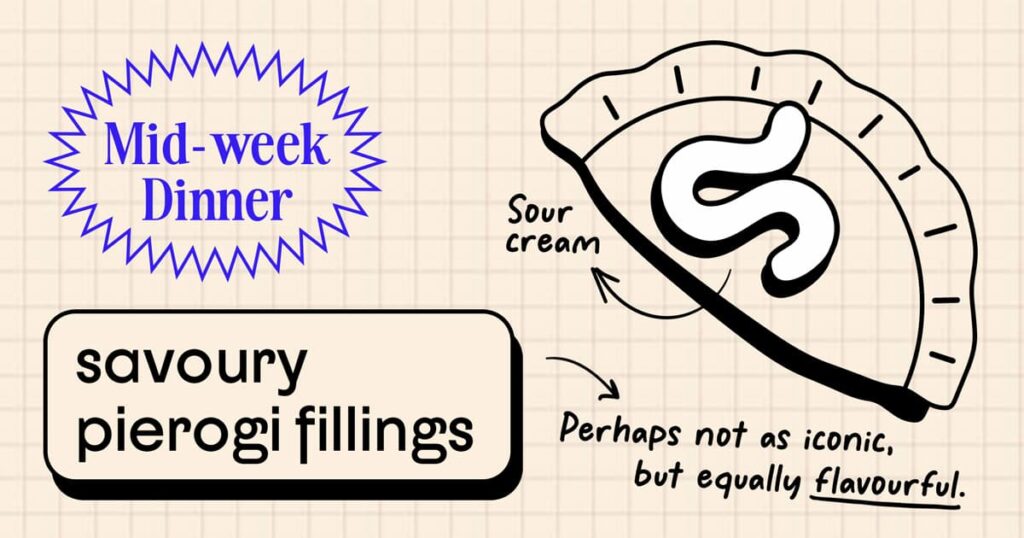
Savoury Pierogi Fillings
While the classic pierogi listed above remain a staple, there are a few less common fillings showing up on Polish tables. Here are some savoury options you may come across:
Spinach
Pierogi ze szpinakiem
Polish for: Spinach Pierogi
Filling pierogi with spinach is a clever way to incorporate more greens into our diet. Spinach leaves are sautéed until tender, often with onions and minced garlic.
Additionally, this filling may include cooked and mashed broccoli, along with ground twaróg (or another sharper cheese), to add an extra layer of flavour.
Blood Sausage
Pierogi z kaszanką
Polish for: Blood Sausage Pierogi
While it’s true that kaszanka (Polish blood sausage) can be an acquired taste, if you already appreciate its unique flavour, this filling might pique your interest. Of course, the quality of the sausage is crucial here, as it largely defines the dish’s taste.
When sautéed with onions, Kaszanka takes on a distinctive, slightly sweet aroma and a smooth consistency. For an added touch, you can spice up the filling with a pinch of cinnamon and ground ginger.
Salmon
Pierogi z łososiem
Polish for: Salmon Pierogi
Transforming leftover salmon fillets into delectable pierogi filling is a savvy move. It can be further enhanced with ground twaróg or cream cheese, fresh dill, and citrus zest.
To bulk up the texture, some recipes call for an addition of buckwheat/millet, mashed potato, or breadcrumbs. Spinach is a popular addition as well.
Savoury Recipes:
- Spinach Pierogi (upcoming)
- Blood Sausage Pierogi (upcoming)
- Salmon Pierogi (upcoming)

Dessert Pierogi Fillings
It’s no surprise that fruit-filled pierogi are a Polish speciality; after all, we’re prominent fruit producers, making this filling choice an obvious one.
While Polish cookbooks brim with sweet pierogi recipes, it’s the simplest ones that hold the most enduring appeal. Among them, bilberry pierogi stand out, reflecting our national affection for all treasures of the forest.
Bilberry
Pierogi z jagodami
Polish for: Bilberry Pierogi
Bilberries, also known as European blueberries, are the perfect fruit for pierogi fillings. Their popularity peaks in the summer when we enjoy them ‘straight from the forest.’ Outside of the season, frozen bilberries are used instead.
Once cooked, bilberry pierogi are bathed in butter, sprinkled with sugar, and paired with sweetened sour cream on the side.
It’s worth noting that bilberries are distinct from regular blueberries you may be familiar with. They are smaller and possess a sharper, more intense flavour.
Strawberry
Pierogi z truskawkami
Polish for: Strawberry Pierogi
Strawberry filling can be prepared throughout the year, but it tastes best in the summer, at the peak of berry season.
Preparation is simple: strawberries are chopped into smaller pieces, sprinkled with sugar, and then wrapped in pierogi dough. When ready, these pierogi taste best with a dollop of sweetened sour cream on the side.
Raspberry
Pierogi z malinami
Polish for: Raspberry Pierogi
Much like strawberries, raspberries make a delightful pierogi filling. It’s simple: whole raspberries, lightly dusted with sugar, get encased in pierogi dough. That’s all there is to it!
Some recipes suggest adding sweetened ground twaróg cheese and/or semolina porridge to the filling, which, in our humble opinion, makes them even better.
Apple
Pierogi z jabłkami
Polish for: Apple Pierogi
For apple pie lovers, this filling is a treat. When it comes to fruit selection, tart apples are preferred over sweet ones. The process involves gently stewing chopped (or grated) apples with a touch of cinnamon and ground ginger.
Apple pierogi can be enjoyed with various accompaniments such as sweetened sour cream, whipped cream, vanilla custard, or even… a scoop of ice cream.
Dessert Recipes:
- Bilberry Pierogi (upcoming)
- Blueberry Pierogi
- Strawberry Pierogi (upcoming)
- Raspberry (upcoming)
- Apple & Cinnamon (upcoming)
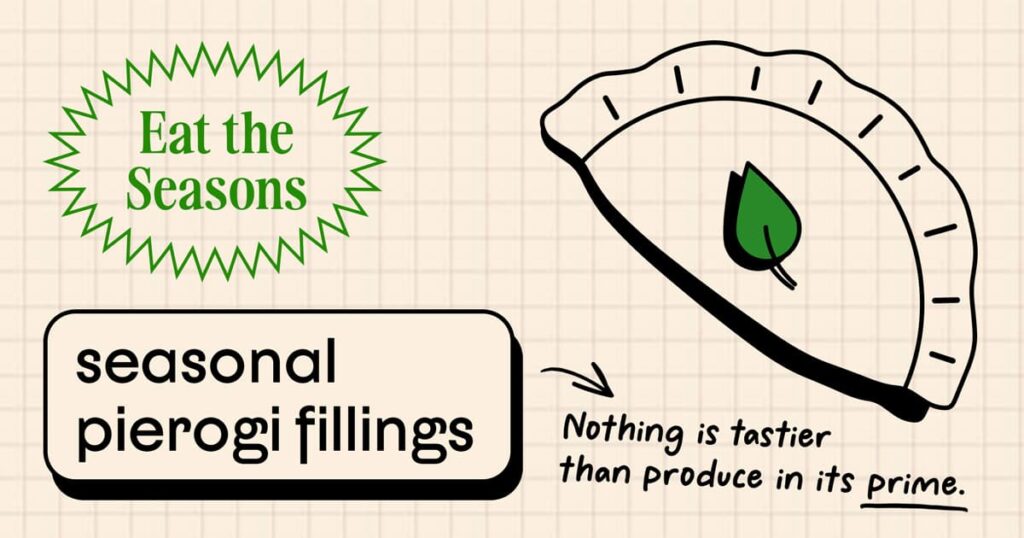
Seasonal Pierogi Fillings
Making the most of local produce in its prime, we’re turning them into exquisite fillings of the season. Here are a few seasonal options you’re most likely to stumble upon:
White Kiełbasa
Pierogi z białą kiełbasą
Polish for: White Kiełbasa Pierogi
Biała kiełbasa is an everyday staple in Polish cuisine, but it’s most closely associated with Easter. During the early spring, it often finds its way into pierogi fillings.
The sausage meat gets removed from its casing and then mixed with sautéed onions. A spoonful of tangy grated horseradish is added as well, providing that sharp, pungent kick.
Sweet Cabbage
Pierogi z młodą kapustą
Polish for: Spring Cabbage Pierogi
Don’t be fooled by the name; this isn’t a dessert. This seasonal filling appears in spring when young, tender spring cabbage becomes available. It’s an earlier-harvested variety with more tender leaves and a milder, subtly sweet flavour.
Chopped cabbage is sautéed with onions, sometimes with smoked bacon, and often enriched with twaróg, mushrooms and/or grated carrots, all seasoned with a copious amount of fresh dill.
Wild Mushroom
Pierogi z grzybami leśnymi
Polish for: Forest Mushroom Pierogi
Mushroom foraging is practically a national sport in Poland, and some of the treasures naturally find their way into pierogi fillings.
The season kicks off in June with chanterelles and returns in September with boletes, saffron milk caps, and more. We use fresh mushrooms in season, resorting to frozen or (rehydrated) dried ones otherwise.
Traditionally, the filling consists of sautéed mushrooms and onions, often seasoned with minced garlic, nutmeg, rosemary, thyme, sage, and/or other herbs. Breadcrumbs may be added for texture as well.
Wild mushrooms also frequently make an appearance as a supporting ingredient in other pierogi fillings, adding that earthy umami vibe.
Pumpkin
Pierogi z dynią
Polish for: Pumpkin Pierogi
In recent years, Poland has seen a rise in pumpkin’s popularity, becoming one of Europe’s leading producers today. And so, as autumn arrives, it is often turned into a hearty pierogi filling.
Roasted pumpkin is puréed and often mixed with twaróg, while ground ginger, nutmeg, and cinnamon infuse warm, fragrant notes.
For added variety, some recipes call for cooked buckwheat, goat cheese, and/or finely chopped nuts.
Duck / Goose
Pierogi z kaczką / gęsiną
Polish for: Duck / Goose Pierogi
In recent years, goose and duck have made a triumphant return to Polish tables – partially thanks to the revival of the age-old tradition of St. Martin’s Day celebrations.
Any meaty leftovers from a festive roast or broth-making now find a second life in various pierogi fillings.
Traditionally, duck or goose meat is paired with sautéed onions, and, depending on the recipe, with stewed apples, dried plums, or citrus zest.
Some recipes call for mashed cooked vegetables such as potatoes, carrots, or parsley root. Such pierogi pair wonderfully with cranberry preserves on the side.
Game Meats
Pierogi z dziczyzną
Polish for: Wild Game Pierogi
In autumn and winter, many chefs and home cooks turn to game (most commonly wild boar and venison) for their pierogi filling.
They often pair it with sautéed onions, dried mushrooms, and dry wine. Some recipes also include chopped prunes or dried cranberries for sweetness, and they season it all with garlic, marjoram, rosemary, and juniper to enhance the flavours.
Poppyseed
Pierogi z makiem
Polish for: Poppyseed Pierogi
Poppyseed pierogi, a seasonal treat reserved for the Christmas season, offer a taste reminiscent of the filling found in Makowiec roll.
The process involves cooking poppy seeds in milk, followed by thorough grinding to a fine consistency.
Honey, along with a mix of chopped dried fruits and nuts, adds flavour and texture. For those seeking convenience, ready-made poppyseed filling is also available.
Seasonal Recipes:
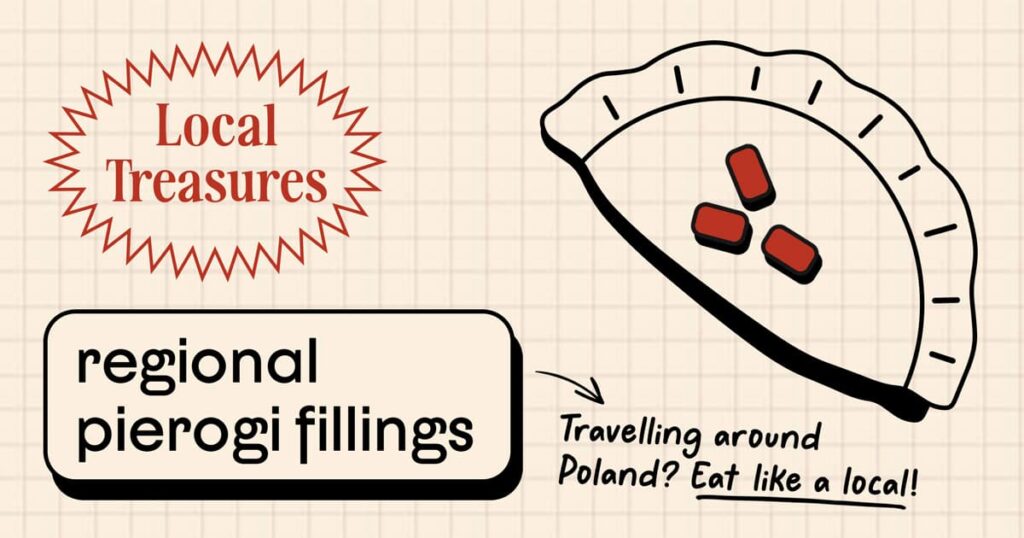
Regional Pierogi Fillings
The beauty of pierogi lies not only in their taste but also in their regional diversity.
As you travel across Poland, you’ll inevitably stumble upon regional delicacies – each often bearing its own unique name and relatively unknown flavour combination outside of its specific locale.
This list isn’t exhaustive, of course; there are many more regional fillings still to discover.
Raw Potatoes
Pierogi z ziemniakami; Szlachcice, Kryzysówki, Podlasiaki
Regions [multiple, among others]: Mazowsze; Podlasie; Lubelszczyzna (Lublin region); Upper Silesia + more
➤ Entries to the “List of Traditional Products” (in Polish): 1, 2, 3
While most pierogi fillings are made with cooked mashed potatoes, this regional take offers a unique approach.
It is made using raw potatoes that are grated, then fried with chopped onions and seasoned with marjoram, salt, and pepper. Some recipes also call for an addition of mashed twaróg cheese, chopped bacon, and/or minced garlic.
Fish (Pike, Carp)
Pierogi z rybą (z karpiem, ze szczupakiem)
Regions: Lubelszczyzna (Lublin region); Małopolska; Mazury
➤ Entries to the “List of Traditional Products” (in Polish): 1
In the picturesque Mazury region, pierogi often feature sweetwater fish like pike, zander, and perch. These fillets are gently steamed, minced, and sometimes combined with egg, fresh parsley, and a hint of lemon zest.
They are served with melted butter or sour cream-based sauces, offering either a subtle citrus twist or a zesty horseradish kick.
In regions abundant in carp-farming ponds, such as Małopolska, carp filling enjoys popularity, especially during the festive season around Wigilia (Christmas Eve).
Some recipes include additions like mashed potatoes, chopped boiled eggs, breadcrumbs, and an assortment of herbs to enhance the flavours.
Bryndza or Bundz Cheese
Pierogi z bryndzą; Bryndziołki
Regions: Małopolska (Highlands), Podkarpacie (Subcarpathia)
Bryndza, a soft and tangy sheep milk cheese, is a key ingredient not only in Polish highland cuisine but also in many mountainous regions of East and Central Europe.
Each home cook prepares this pierogi filling in their unique way, often incorporating various additional ingredients such as sautéed onions, smoked bacon, mashed potatoes, grated oscypek cheese and fresh herbs like rosemary or thyme.
Buckwheat
Pierogi z kaszą gryczaną
Regions [multiple, among others]: Mazowsze, Lubelszczyzna (Lublin region), Pomorze (Pomerania), Lubuskie
➤ Entries to the “List of Traditional Products” (in Polish): 1, 2, 3, 4, 5
Buckwheat groats play a distinctive role in many regional cuisines. When comes to pierogi fillings, each locality has its own preference for any additional ingredients.
They range from classics (such as sautéed onions, bacon, ground twaróg, mushrooms, or boiled potatoes) to more surprising choices such as fresh mint or nettle leaves.
To prevent the filling from becoming too dry, a raw egg is often incorporated to improve the texture.
Millet
Pierogi z kaszą jaglaną
Regions: Lubelszczyzna (Lublin region), Podkarpacie (Subcarpathia)
➤ Entries to the “List of Traditional Products” (in Polish): 1, 2, 3
Millet’s long-standing presence in regional Polish cuisine, dating back centuries, is owed to its ability to thrive in less fertile soil. This culinary gem is cooked in milk and often combined with ground twaróg for a comforting pierogi filling.
The sweet variation introduces sugar and cinnamon, sometimes complemented by fruits or finely chopped nuts.
In the savoury rendition, the flavour is enriched by sautéed onions, mushrooms, or grated yellow cheese, along with a touch of ground savory herb.
Lentils
Pierogi z soczewicą
Regions: Mazowsze, Lubelszczyzna (Lublin region), Podkarpacie (Subcarpathia)
➤ Entries to the “List of Traditional Products” (in Polish): 1, 2, 3
When it comes to pierogi fillings, lentils of every hue can find their place. The preparation starts with sautéing onions along with pre-cooked lentils. These are then ground or blended together to create a smooth mixture.
In certain regional variations, mushrooms (either dried or fresh) or sauerkraut might be added as well. The filling is typically seasoned with minced garlic, dried marjoram, and/or thyme.
Broad Beans
Pierogi z bobem
Regions: Lubelszczyzna (Lublin region), Podkarpacie (Subcarpathia)
➤ Entries to the “List of Traditional Products” (in Polish): 1, 2, 3
Broad bean pierogi filling can remain meatless or become meaty with the smokiness of bacon. In the Lublin area, yet another interesting twist emerges with the inclusion of ground pork collar meat.
As summer unfolds, this regional treat has recently found its way outside its traditional borders and onto the seasonal menus of eateries across the country.
Red Beans
Pierogi z czerwoną fasolą
Regions: Lubelszczyzna (Lublin region)
➤ Entries to the “List of Traditional Products” (in Polish): 1
Red bean-filled pierogi have long been a traditional staple on the tables of the Lublin region. They are not only cost-effective but also incredibly satiating.
Red beans are commonly paired with sautéed onions, bacon, or pork collar, all ground together into a hearty filling.
White Runner Beans (Emergo)
Pierogi z fasolą Jaś
Regions: Małopolska
➤ Entries to the “List of Traditional Products” (in Polish): 1
In the culinary tradition of the Dunajec Valley, white runner beans, locally known as “Piękny Jaś,” have been a staple since the 17th century.
For a savoury pierogi filling, cooked beans are mashed or ground and seasoned with garlic, salt, and pepper. Then, sautéed onions and either pork lard or goose fat are added, harmoniously binding the mixture.
In sweet variations, cooked beans undergo mashing or grinding as well. This time, butter and sugar are added to taste. Depending on the recipe, a hint of cocoa, dried plums, other dried fruits, and ground vanilla might also be included in the blend.
Dried Prunes
Pierogi z suszonymi śliwkami
Regions: Małopolska
➤ Entries to the “List of Traditional Products” (in Polish): 1
In the culinary traditions of Małopolska, pierogi filled with dried plums are an iconic speciality, particularly cherished in parts of the Island Beskids and the northern regions of Gorce Mountains.
To prepare the filling, dried prunes, locally known as “płonki,” are soaked in boiling water and then simmered for 10-15 minutes until they become tender. Afterwards, they are drained and allowed to cool.
Each individual prune is then wrapped in pierogi dough. In certain recipes, prunes are mashed into a dense, butter-like paste, which is used as the filling. The completed dish is garnished with melted butter and a sprinkling of sugar.
Regional Recipes:
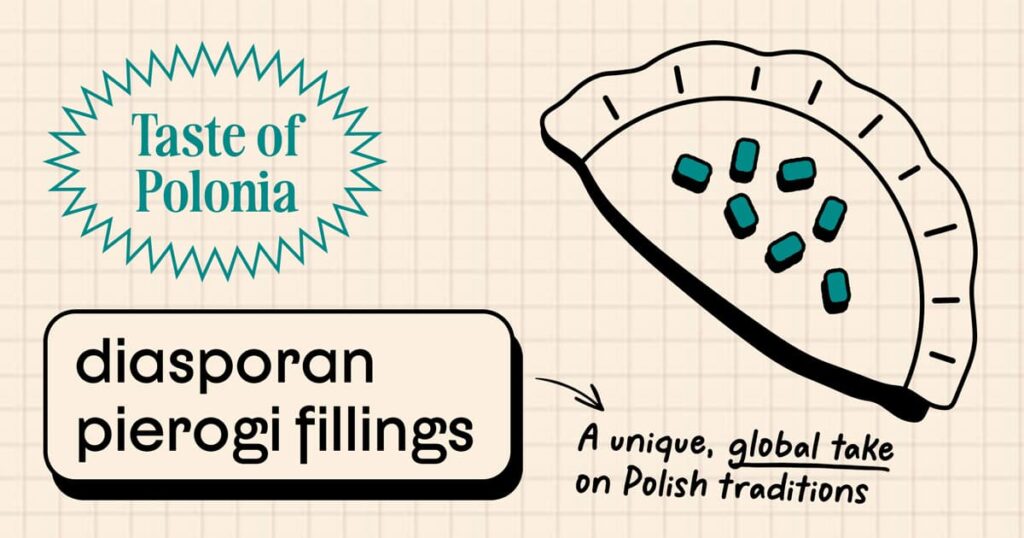
Diasporan Pierogi Fillings
Przepisy Polonijne
In the ever-connected world, borders tend to blur – and our culinary traditions don’t exist in isolation. Polish immigrants have made do with what’s on hand, whether due to financial constraints or limited access to traditional Polish ingredients.
This is when our characteristic Polish ingenuity shines through: ingredients are added, omitted, or substituted, giving rise to new recipes.
Here are some pierogi fillings that reflect the creativity of Polish communities abroad:
Potato and Cheddar
Pierogi ruskie z cheddarem
Twaróg, a quintessentially Polish ingredient, can be a real challenge to find abroad. Although it can be made at home, the process demands time and dedication.
This scarcity has led to the substitution with more accessible dairy options. In the US, a beloved variation of ‘ruskie’ pierogi filling consists of mashed potatoes and grated cheddar.
This combination gained popularity through a ready-meal manufacturer (albeit with a disheartening Americanized spelling of ‘pierogi’…).
Note on availability
Preparing pierogi from scratch isn’t a task for the faint-hearted. While not overly complicated, it can be very labour-intensive. Yet, despite the effort involved, countless home cooks take on the challenge, often making pierogi in generous batches and sharing them among family and friends.
But for those days when spending hours in the kitchen isn’t feasible, there’s an easier solution. Ready-made pierogi, featuring a wide array of fillings, are readily available in supermarkets across Poland.
If you’re in the mood for something more sophisticated, artisanal options can be found in premium delis and restaurants, often boasting intricate flavour combinations.
Internationally, most Polish stores offer ready-made pierogi, either frozen or fresh & chilled, ready to be reheated at home.
Final thoughts
It’s important to note that there’s no such thing as an “authentic” pierogi recipe. Each of us has our own unique experience of these dumplings – either from family home, region of origin, or extensive travels.
Moreover, every chef and every home cook adds their own personal touch, resulting in an endless array of combinations.
And so, it’s worth keeping an open mind and staying curious; there’s always more pierogis filling to discover.
Frequently asked questions
Note: This article was originally published on April 25, 2019.





